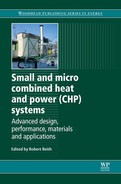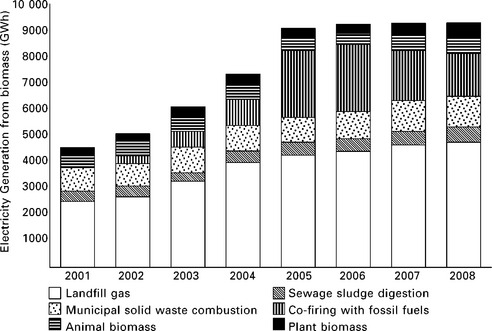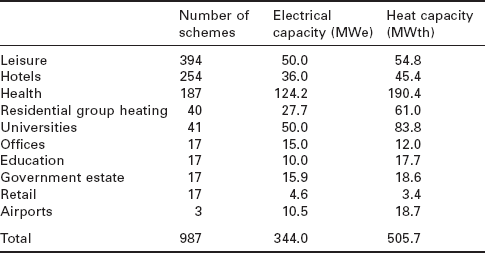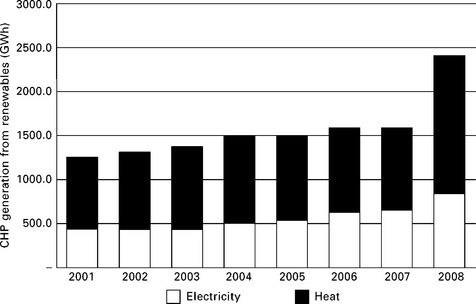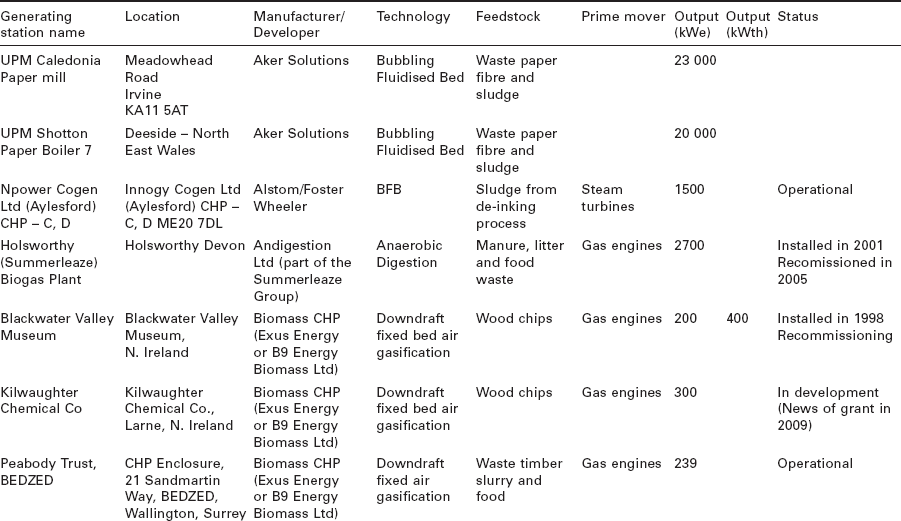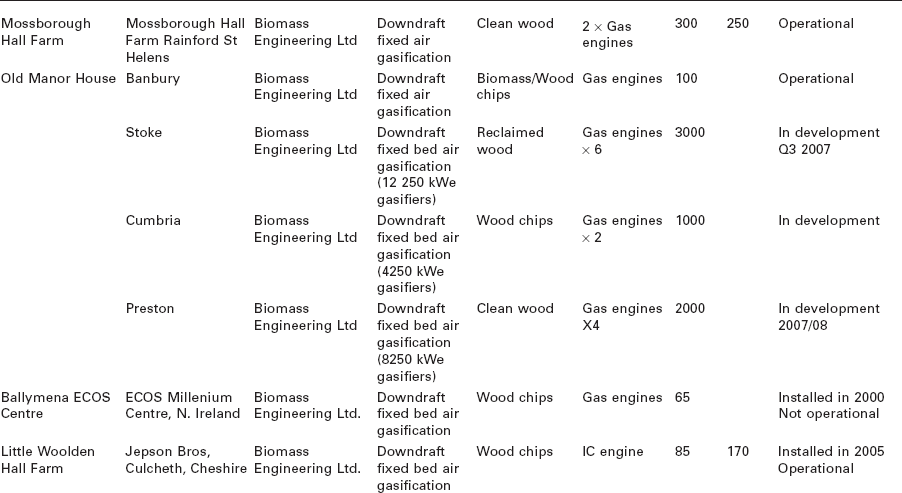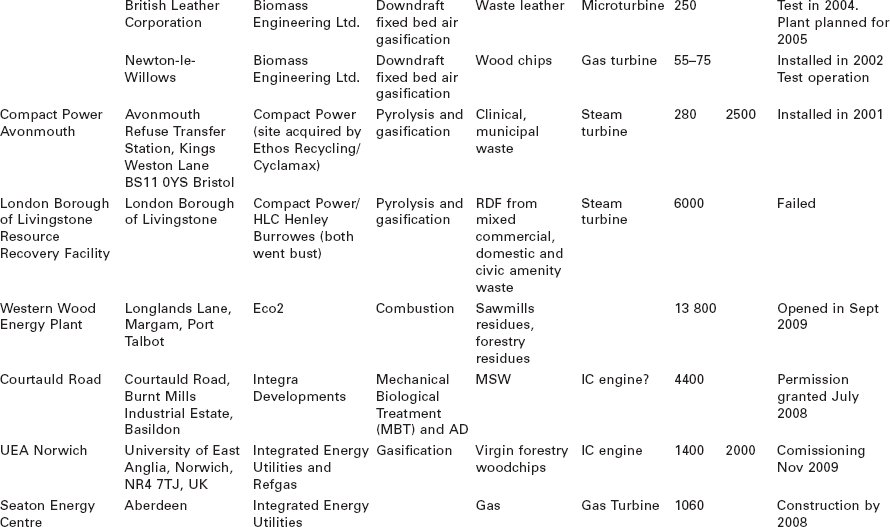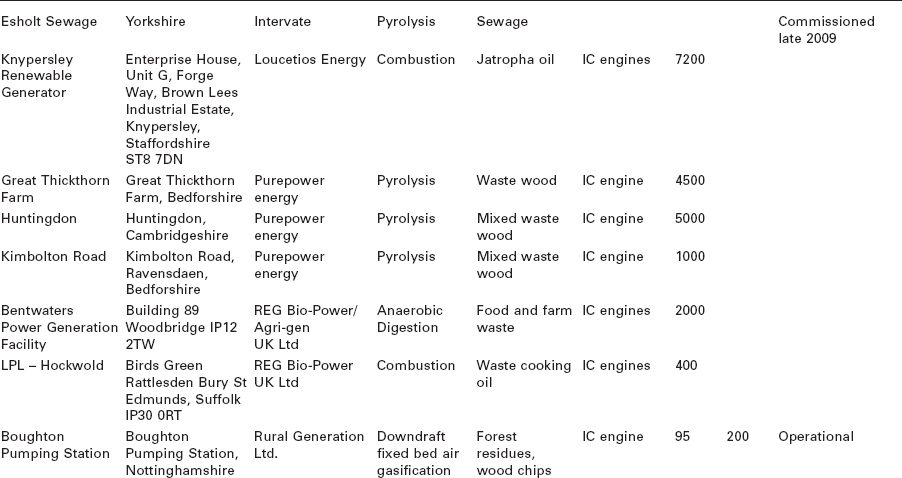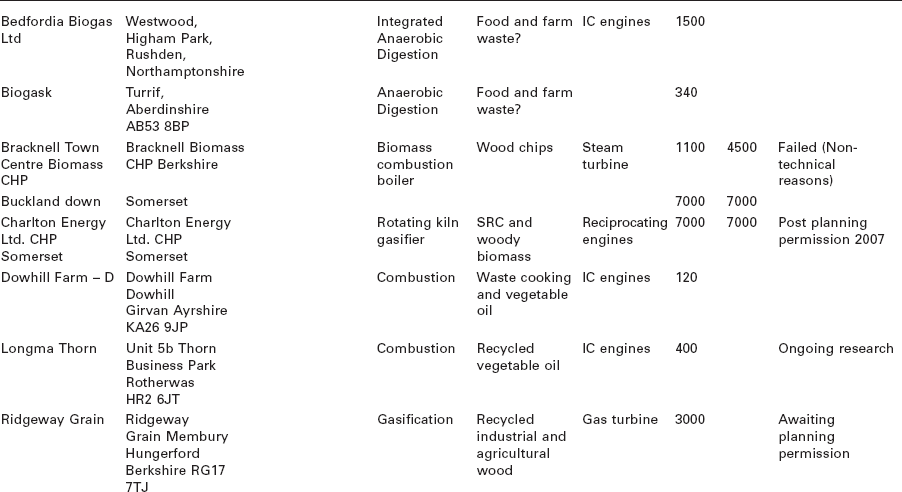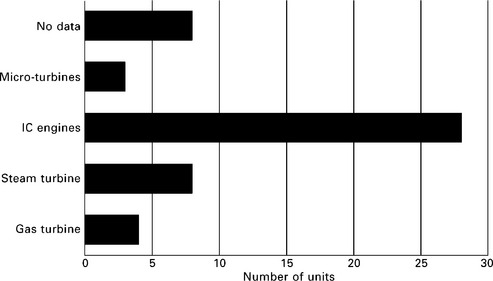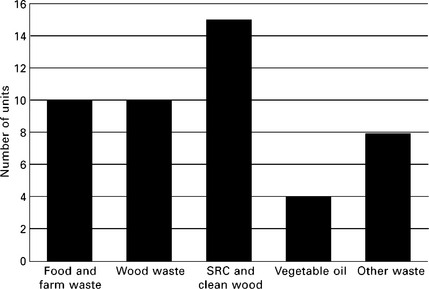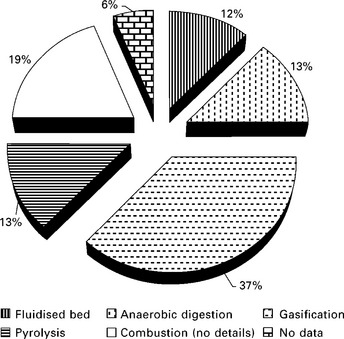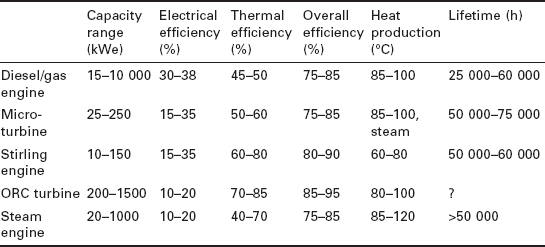Biomass-based small and micro combined heat and power (CHP) systems: application and status in the United Kingdom
Abstract:
This chapter discusses the current state of biomass-based combined heat and power (CHP) production in the UK. It presents an overview of the UK’s energy policy and targets which are relevant to the deployment of biomass-based CHP and summarises the current state for renewable, biomass and CHP. A number of small-scale biomass-based CHP projects are described while providing some indicative capital costs for combustion, pyrolysis and gasification technologies. For comparison purposes, it presents an overview of the respective situation in Europe and particularly in Sweden, Finland and Denmark. There is also a brief comment about novel CHP technologies in Austria. Finally it draws some conclusions on the potential of small-scale biomass CHP in the UK.
this work was partially supported by the European Commission through the Bioliquids CHP project (http://www.bioliquids-chp.eu/).
17.1 UK energy policy and targets
In February 2003 the Government published the Energy White Paper (1) setting a target of 20% of electricity produced from renewables by 2020, and biomass is categorised in Government energy policy as part of renewables. Onshore and offshore wind and biomass could be the largest contributors to the renewables generation mix in 2020. The Government accepted the recommendation of the royal commission on environmental pollution to reduce carbon emissions by 60% by 2050 and stated their commitment to a target of 10 GWe of ‘ good quality’ combined heat and power (CHP) capacity being installed by 2010.
CHP is defined as simultaneous generation of usable heat and power in a single process, with the advantage of offering much higher overall energy efficiency (up to 85%) compared to electricity production only (rarely exceeds 35%). CHP that is certified as ‘good quality’ is exempt from the Climate change Levy imposed on electricity and gas sales for non-residential energy users.
Biomass is defined as ‘the biodegradable fraction of products, waste and residues from agriculture (including vegetal and animal substances), forestry and related industries, as well as the biodegradable fraction of industrial and municipal waste’ (2).The Biomass Task Force Report by Sir Ben Gill published in October 2005 stressed that ‘Biomass is unique as the only widespread source of high-grade renewable heat’ (3).The report challenged the Government to recognise that biomass heat can save carbon and help deliver the climate change agenda at a cost favourable to other options.
The Government’s stated their agreement with the Biomass Task Force Report, specifically with the conclusion that renewable heat provides important opportunities and is a particularly efficient way of cutting carbon emissions, provided that there is a secure market for the heat generated (4). At the same time the Government acknowledged the contribution that biomass can make to renewable electricity targets through co-firing or dedicated electricity generation. A working group, the Biomass Implementation Advisory Group, has been formed by the UK Department for Environment, Food and Rural Affairs (Defra) to oversee progress in implementing the recommendations.
In the framework of these recommendations a five-year new Bio-energy Capital Grant Scheme targeted at biomass heat and CHP was launched on 29 December 2006. This supported the installation of biomass-fuelled heat and CHP projects in the industrial, commercial and community sectors, worth £10-15 m in England over the first two financial years to March 2008. The first two rounds of the Bio-energy Capital Grant Scheme allocated grants to project developers and organisations investing in heat and/or electricity generating projects fuelled by energy crops and other biomass feedstocks creating new bio-energy markets. Round six was announced in December 2009 and was open for applications until 31 March 2010.
Microgeneration is defined as the small-scale production of heat and/or electricity from a low carbon source (5). Solar, micro-wind, micro-hydro, heat pumps, biomass, micro combined heat and power (micro-CHP) and small-scale fuel cells are all considered microgeneration technologies. Micro- CHP is defined as CHP with an electrical capacity of less than 50 kW (6). A number of programmes and actions have been adopted by the Government to support microgeneration:
• The Low Carbon Buildings Programme launched by the DTI in April 2006 superseding the previous Clear Skies Initiative and Solar PV programmes (7). The programme provides grants for a number of microgeneration technologies for householders, community organisations, schools, the public sector and businesses. An accredited installer and product are prerequisites for grant eligibility. A list is available from Clear-Skies (http://www.clear-skies.org/).
• A field trial of micro-CHP units run by the Carbon Trust (funded by the Government), monitoring the energy and financial savings. The Carbon Trust provides finance for carbon-reduction projects.
• A Value Added Tax (VAT) rate reduction on micro-CHP units from 17.5% to 5% since April 2005.
• The introduction of new Building Regulations in April 2006, with changes to the regulations on energy conservation encouraging the use of low or zero carbon (LZc) systems to combat climate change.
• The UK-wide Community Energy Programme (now closed) provided funding to promote public sector community heating through capital grants to install new schemes and refurbish outdated infrastructure and equipment, primarily using CHP technology.
In July 2006 the Government published its energy review (8), in which it was concluded that on present policies, the UK is on course to exceed its target under the first commitment period of the Kyoto Protocol, this is, to cut overall greenhouse gas emissions by 12.5% on 1990 levels throughout the period 2008-12. However, the growing energy consumption combined with higher levels of electricity generation from coal has led to higher carbon emissions. As a result further action has to be taken in order to achieve the goal of cutting carbon emissions by 60% by 2050 following the recommendation of the Royal Commission on Environmental Pollution.
Renewable energy is an integral part of the Government’s strategy for tackling climate change. The key support mechanism for the expansion of renewable electricity is the Renewables obligation (RO) on all electricity suppliers in the UK to supply a specific proportion of electricity from eligible renewables. This has succeeded in bringing forward major and minor developments of the most economic forms of renewable energy, in particular onshore wind, landfill gas, and co-firing of biomass in coal-fired power stations. The level of the RO is due to rise from 10% by 2010 to about 15% in 2015-16. Although not given special focus in the energy review, biomass is seen as a key component of the general mix of renewables and will make an important contribution, particularly as a source of distributed energy. At the same time the introduction of the EU Emissions Trading Scheme (ETS) creates a strong economic incentive for biomass technologies by putting a price on carbon.
Ignoring climate change will eventually damage economic growth and risk irreversible disruption to economic and social activity. Strong, early action is needed to tackle climate change with initiatives such as investment in higher energy efficiency and low or zero carbon emission technologies of which biomass and biomass-fuelled CHP are key contributors.
17.2 Renewables and combined heat and power (CHP) in the UK
In these sections we look first at the broad picture of electricity produced from renewables, then in Section 17.2.2 we review heat from renewable biomass-based heat production. In Section 17.2.3 we comment on CHP in the UK, then in Section 17.2.4 we focus on the renewable-based CHP.
17.2.1 Renewables and biomass electricity generation in the UK
According to the UK Energy Digest (9), the largest contribution to renewables in input terms for 2008 (over 81%) is from biomass, followed by large-scale hydroelectricity production. Only 12.2% of renewable energy comes from renewable sources other than biomass and large-scale hydro (solar, wind, small-scale hydro and geothermal aquifers). Total electricity generation from renewables, excluding non-biodegradable waste in 2008 equalled 21 597 GWh showing a 10% increase compared to electricity generation in 2007 and accounting for 5.5% of the total electricity generated.
With biomass derived fuels such as landfill gas, sewage sludge and municipal solid waste, a substantial proportion of the energy content is lost in the process of conversion to electricity. Therefore, although in input terms the contribution of biomass to renewable electricity generation in 2008 was over 81%, in output terms it was 43.1%; this accounts for 9315 GWh and 2.4% of the total electricity generation in the UK that year. In 2007, some 9270 GWh of electricity were generated from biomass, comprising 47.2% of the renewable electricity generation. Recent years have reached a plateau in the total electricity generated from biomass, as shown in Fig. 17.1, with a slight increase from 2007 to 2008 due to the contribution of landfill gas, animal and plant biomass, with a small decrease in co-firing biomass with fossil fuel.
A list of currently operational and under development biomass electricity projects is presented in Table 17.1. Sewage gas and landfill gas plants are not included in the list although they make a significant contribution. This table does not claim to be exhaustive; however, it does represent the best of our knowledge at this time. This is a dynamic area and new projects are likely to be forthcoming over the next few years.
17.2.2 Biomass heat generation in the UK
According to a study conducted by Future Energy Solutions (12), in 2005 the production of heat accounted for approximately 30% of total energy consumed in the UK excluding transport. The main provider of heat is natural gas, only 1% is generated from renewable energy sources. On the other hand, 94% of renewable heat comes from biomass. figure 17.2 shows that the level of heat generated from biomass has been steadily increasing since 2005 after a short decline due to tighter emissions controls discouraging the burning of waste wood. Domestic use of wood is still the main contributor to renewable heat generation whereas the input of industrial wood waste has decreased from 225.2 thousand tonnes of oil equivalent (ktoe) in 2001 to just 93.1 ktoe in 2005 rising again in 2008 to 107.6 ktoe.
Residential wood fuel systems are increasing in popularity under the DTI’s Low Carbon Buildings Programme. They vary from stand-alone stoves of 6-12 kwth fuelled by logs or pellets providing space heating for a room, to boilers larger than 15 kwth connected to central heating and hot water systems fuelled by pellets, logs or chips.
Capital costs depend on the type and size of the specific system and installation and commissioning costs. For a stand-alone room pellet-fuelled heater the price range is around £1500-£3000 which is just the cost of buying the unit. A typical 20 kwth pellet boiler would cost around £5000 to install including the cost of the flue and commissioning, whereas a 20 kwth manual log feed system would be slightly cheaper (13).
Fuel supply is the principal operating cost for a biomass heat system. It includes sourcing the fuel, processing the fuel to required specifications (e.g. chipping, sieving and drying for wood chips) and transporting the fuel. The bulky nature of biomass in combination with its lower energy density compared to that of fossil fuels results in higher transport costs. The Biomass Energy Centre (14) published indicative domestic scale delivered biomass fuel costs (pence per kwh, 2010):
Small-scale (up to 350 kwth) biomass heat systems are more viable in areas not connected to a natural gas line, where their higher capital cost is offset by the lower cost of biomass fuels compared to the cost of oil and liquid petroleum gas (LPG). However, due to increased oil and gas prices, significant potential has arisen in all areas for larger-scale heating projects of more than 350 kW, e.g. community heating, particularly where there is a high or predictable heat demand.
17.2.3 CHP in the UK
Combined heat and power offers higher carbon savings per tonne of fuel than the current centralised scheme for power generation. In CHP the heat generated is recovered and utilised for industrial processes, community heating or space heating. It is noteworthy that heat demand is the driver in CHP, and electricity is a useful by-product. Therefore heat projects have the potential to become CHP projects. The economics of the energy markets may alter this balance in the future.
According to the 2008 UK Energy Digest (15) some 1439 CHP schemes were operating in the UK with an installed capacity of 5469 MWe generating 27 911 GWh of electricity (7.24% of the total electricity generated in the UK) and 52 197 GWh of heat. This represents a 72 MWe increase in installed capacity equivalent to a 1% increase in electricity generation between 2004 and 2008. In terms of electrical capacity, schemes larger than 10 MWe represent 83% of the total installed capacity. However, in terms of number of schemes, the largest share is in schemes less than 1 MWe (81%).
With regard to buildings, the largest proportion (from the capacity point of view) is in the health sector, mainly hospitals, whereas leisure and hotels account for more than half the total number of schemes, as shown in Table 17.2. In fact, these three sectors account for 85% in terms of number of units installed, 61% of all electricity capacity and 57% of heat capacity.
The major fuel used in CHP schemes in 2008 was natural gas. It comprised 71.1% of the overall fuel used, whereas renewable fuels comprised only 3.7% including sewage gas, other biogases, municipal waste and refuse- derived fuels. The breakdown of the fuel input for CHP schemes in the UK is depicted in Fig. 17.3.
Micro-CHP is defined as CHP units with an electrical capacity of less than 50 kW. Micro-CHP units are typically operated as conventional boilers, providing space heating and warm water in residential or commercial buildings. However, unlike boilers, micro-CHP units generate electricity together with the heat at very high efficiencies. Most units operate in grid-parallel mode, so that the building can either receive electricity from or export to the network. Of the 24 million households in the UK, as many as 14 to 18 million are thought to be suitable for micro-CHP units comprising approximately 20 Gw of electrical capacity in total (17).
17.2.4 Renewable CHP generation in the UK
As was mentioned in the previous section, only 3.7% of the fuels used for CHP generation in 2008 were renewable, i.e. sewage gas, other biogases, municipal waste and refuse-derived fuels, resulting in the generation of 838 gwh of electricity and 1566 gwh of heat. Figure 17.4 shows that the increase in CHP generation from renewables for the period up to 2007 is slow, with an average of a 2% increase for heat and 7.43% increase for electricity.
A list is presented in Table 17.3 showing the current biomass CHP plants in the UK. Sewage gas, landfill gas plants and biomass co-firing in coal-fired power stations are not included in the table. table 17.3 is not claimed to be exhaustive. It is certain that there are projects in development with undisclosed details and even some of the projects in development included in the list could be facing problems with planning and environmental permissions and therefore may not come to fruition. On the other hand this is a dynamic area and new projects are likely to be forthcoming over the coming years. Table 17.3 can be rearranged in the form of charts for easier interpretation as in Figs 17.5-17.8.
Figure 17.5 demonstrates that large projects (over 1 MWe) dominate the UK’s biomass CHP scene followed by schemes smaller than 400 kwe. this is of particular importance for market research of future opportunities in the CHP market because it dictates the current trend of biomass CHP appeal, thus the most likely market in which continued growth could be achieved as well as areas in which help is needed in order to promote future growth. Another factor to consider when analysing units by output or size is the modularity of the small-scale schemes and the possibility of growing and thus achieving higher outputs by simply adding modules. Examples of small-scale modular biomass CHP systems are detailed in Sections 17.2.5-17.2.7.
Figure 17.6 shows a trend towards the use of internal combustion engines as prime movers when compared to any turbine technology. As expected for a mature technology, it dominates the market as a result of its reliability and expected performance. A similar situation is reflected in the figures specifically for steam turbines. It is important to mention that the micro-turbines referred to in this study are from Talbott’s, whose technology hold is on air-driven micro-turbines. The figure also exposes the need for continued research efforts into turbine technology, in order to fill the technical gap between turbines and IC engines. This would undoubtedly bring down costs and promote its use.
In Fig. 17.7 the advantage is for short rotation coppice (SRC) and clean wood to be used as feedstock for biomass CHP in the UK. All other feedstocks are a waste variety, that is, food and farm waste, wood waste, recovered vegetable oils and other waste. This leads to further re-arranging into three distinct categories:
• clean fuel (SRC and clean wood) represents 32%
• fuels of waste origin (food, farm, wood and vegetable oil) stands for 51%
If, on the other hand, all wood-derived fuel sources are grouped together, then the figures change as follows:
• wood fuels (SRC, clean and waste wood) will now represent 53%
• waste fuels (food and farm waste and vegetable oils) is now 30%
once more, this fact is important in terms of future opportunities as the market of wood-derived fuels and for the disposing (or making use) of waste seems to be one of the main drivers towards biomass CHP.
Biomass gasification is an established technology that has been in the commercial market for some time now. In Fig. 17.8 the dominance of gasification over the other technologies is acknowledged. Combustion technologies, anaerobic digestion and pyrolysis are lagging behind gasification in terms of number of units in service and thus market penetration. It is significant to note that, despite its suitability for the disposal of organic matter, anaerobic digestion has not taken a significant proportion of the UK’s biomass CHP market, in a marked difference with other European countries.
Summarising the findings of Table 17.3, the UK biomass CHP market can be characterised by a typical facility being larger than 1000 kwe, using waste as fuel in a gasifier feeding an internal combustion engine.
17.2.5 Examples of past and present small-scale biomass gasification companies
Biomass engineering
Biomass Engineering (18) is a company that has succeeded in the fields of design, manufacturing and installation of biomass gasification systems. Using energy crops, waste wood, wood chippings and forestry wood as fuel, they have managed to secure the following projects.
ECOS Millennium Centre, Ballymena, N. Ireland (19)
A 65 kwe gasification system comprising a downdraft gasifier, char and ash removal, gas conditioning and cooling, with wood preparation (cutting, drying, conveying) and power generation with modified diesel engine, was provided to Ballymena Borough Council, Northern Ireland in 1999. The main objective was to supply heat and electricity for the ECOS Millennium Centre as part of a series of renewable initiatives built into the project. Over 3500 hours of operation on a wide variety of wood types was obtained, with continuous test runs of up to 10 hours (specified by the client). The gasifier has now been dismantled.
Mossborough Hall, Merseyside (20)
This is a 300 kwe CHP demonstration plant partially funded by the DTI. The plant is on a mixed use farm with a green waste licence and it is used to gasify chipped logs and clean waste wood. It operates unmanned with remote monitoring and comprises a wood-based downdraft gasification system with dry gas cleaning and two gas engines. The electricity produced is exported to the grid. Radiated heat and diluted exhaust gases are used for fuel drying.
Little Woolden Hall Farm, Culcheth, Cheshire
Biomass Engineering has installed and commissioned an 85 kwe CHP gasification system at a farm site in Culcheth, Cheshire for Jepson Bros Ltd, which comprises woodchip feeding, gasifier and power generation. Heat is used for wood drying and the electricity is sold to the grid.
Biomass CHP
Biomass CHP is another company heavily involved in biomass CHP projects in the UK based on gasification technologies. Among their projects are the following.
Blackwater Valley Museum, Benburb (21)
A 200 kwe/400 kwth biomass gasification plant designed by Exus Energy (formerly known as B9 Energy and now part of Biomass CHP) is located at the Blackwater Valley Museum, Benburb, Northern Ireland. It uses sawmill wood chips to provide heating for the museum and electricity for about 400 homes. The wood chips are dried from about 50% water content to 10-15% using waste heat from the engine cooling system before being fed into a downdraft gasifier. The producer gas is cleaned, cooled, mixed with air and fed into the engine with 10% diesel for ignition purposes. The engine heat exhaust is recovered via heat exchangers. The resulting hot water is then pumped to the radiators in the museum for space heating via an underground heating network. Overall energy efficiency is 70% and the capital cost has been estimated at about €280 000.
Beddington ZED (22)
The Beddington Zero Energy Development Project (BedZED) was a novel mixed development (housing and offices), completed in 2002, owned by the Peabody Trust, London’s largest housing association. Biomass CHP designed, installed and commissioned a 130 kwe CHP unit which provided the site with electricity and heat in the form of hot water, distributed around the site via a district heating system of super-insulated pipes. The plant used off-cuts from tree surgery waste that would otherwise go to landfill. The CHP plant is no longer in operation and the system has been dismantled.
Rural Generation Ltd
Gasification is the main technology employed by Rural Generation Ltd in the following projects.
Brook Hall Estate, Londonderry, Northern Ireland (23)
Brook Hall Estate has been operating a wood-fuelled gasifier on the farm since 1996. Heat and electricity were initially produced from forestry residues, while willow coppice was being established. Wood chips or willow chips are fed to a downdraft gasifier linked to a modified Iveco diesel engine. The system can produce 95 kwe and 200 kwth. It ran in batch mode and typically operated for 12-14 hours per day producing electricity, which was exported to the UK National Grid while the thermal energy was used to dry cereals from the farm. The heat was also used in the winter months to dry willow chip that would subsequently be used in the gasifier. The project is currently not operational (24).
Boughton Pumping Station
The station houses a biomass CHP plant that runs on wood chip forest residue. The plant was installed in May 1999 but began operating regularly in autumn 2000 due to problems with the fuel source. Waste wood chips were converted into gas, which was then mixed with 20% diesel to fuel the engine. (Diesel is required for ignition and lubrication purposes.) The engine ran for 8 hours a day, providing 95 kW electricity and a thermal output of around 200 kw. Around 60% of the electricity generated was exported to the UK National Grid. This plant is not operational at the moment (24).
17.2.6 Examples of past and present small-scale biomass pyrolysis + gasification examples
Compact power
Compact power, Avonmouth, Bristol (23)
This project has been operating for 5 years. It processes 800-1000 kg of clinical and/or municipal waste per hour. The waste is first pyrolysed in two tubes and the char residue is steam gasified in a close coupled gasifier with the product gas mixed directly with the pyrolysis gas. The combined gas is then burned in a cyclone burner with the exhaust providing heat for the pyrolysis chamber and a steam boiler. A maximum of 280 kW of power and 2.5 MW of heat can be generated from the process. The unit is a demonstration for larger capacity units that will be built on a modular system with multiple pyrolysis tubes. the emissions performance is exceptionally good because of the good control of the gas combustion process and the high temperature. Dioxin levels have been measured at less than 0.003 ng/nm3. The unit is fully licensed for commercial use by the UK Environment Agency.
17.2.7 Examples of past and present small-scale biomass combustion examples
Talbott’s
Talbott’s Biomass Energy System (25) specialises in the development of combustion based energy systems. An example is presented below:
Harper Adams University College (26)
A biomass indirectly fired air turbine system developed by Talbott’s Heating is being demonstrated at a leading agricultural college in Shropshire, Harper Adams University College. The CHP demonstration plant provides 100 kw of electricity and 200 kw of heat employing a Brayton Cycle that uses clean hot air for turbine operation. The electrical energy is sold back to the National Grid providing an extra income for the college. The thermal energy provides heating and hot water for the university buildings. The plant was officially launched in spring 2006.
17.3 Technical challenges for small-scale biomass combined heat and power (CHP) systems
Biomass CHP systems are subject to a number of technical problems relating to fuel and operation and are therefore often criticised. Both the biomass source and the technical challenges facing the prime movers are outlined in the following sections.
17.3.1 Difficulties associated with biomass fuels
The more frequent difficulties associated with biomass fuels are described below.
Energy efficiency, energy balance and carbon neutrality
Although the burning of biomass releases the same amount of CO2 previously captured within the organic matter, the production and transportation stages of biomass do add to the greenhouse effect. The extent to which a particular biofuel has an impact on the global energy balance is still subject to debate, some claiming minimal or no CO2 reduction while others propose at least moderate reductions.
Biodiversity and land use
There is mounting concern that the increased use of biofuels may displace the native ecosystem into cropland for fuels. The loss of biodiversity is not only a moral pressure, but a technical one as well, as the crops will have a reduced ability to cope with blights.
Food shortages
The above concern also underlines the fear of food shortages if energy crops replace food crops. However, there is optimism that increases in food crop productivity and yields, together with better land use management and higher yields from second-generation biofuels (non-food-based crops) will overcome this issue.
Supply and security of supply issues
Biomass as a fuel is still, to a great extent, a developing market. In particular solid biomass has to deal with concerns associated with its bulky nature and large space requirements, widely dispersed nature, high handling and transport costs, low heating value or energy density, issues related to biomass conditioning or fuel preparation prior to conversion (such as drying and specific size requirements) and finally harmful emissions during the conversion process. Liquid biofuels face similar but substantially lesser difficulties, summarised in the steps normally taken towards avoiding/minimising contamination, upgrading, differences when compared to conventional liquid fuels and the discharge of harmful emissions such as smoke, particulates, and NOx. In terms of issues related to security of supply, a recent report by IEA in 2007 states that ‘the implications of the use of biofuels for global security as well as for economic, environmental, and public health need to be further evaluated’ (27).
17.3.2 Difficulties associated with prime movers
IC engines
These are the preferred prime movers for small-scale biomass CHP systems, mainly because of their higher efficiency when compared to other prime movers, fuel flexibility and robustness. However, a number of issues have been identified for use with biomass derived fuels, mostly related to fuel properties such as lower heating value and higher water content, which will in turn de-rate the engine output. Fuel quality is a major issue including high viscosity, particulates, stability, low temperature properties, acidity and consistency. General issues related to IC engines are the amount of vibration that needs to be damped, as well as issues with low frequency noise and maintenance, which is more frequent when compared to a turbine.
Turbines
The selection of turbines as prime movers is hindered by the very limited number of units claiming to be able to run on biomass fuels, as this technology is at an early development stage. The turbine efficiency will be negatively affected when fed by a lower heating value fuel and may not be possible at all in extreme cases. In addition, turbines tend to be more expensive than IC engines and maintenance is more technically demanding. Fuel conditioning is also important when operating a turbine with biomass derived fuel, especially in regard to removing solid particulates due to their corrosion and erosion effect. There is also a possibility that the nitrogen components in the biomass derived fuel will contribute to an increase in Nox emissions levels, although generally speaking the emissions rates are lower when compared to an IC engine. Other general issues associated with turbines as prime movers in general are the higher noise levels, large amount of hot flue gases to handle, lower efficiency when compared to IC engines, low efficiency when operating at part load and low efficiency at high ambient temperatures. There are also concerns over durability and reliability that can only be overcome with very long-term trials and experience.
17.4 Capital costs for small-scale biomass combined heat and power (CHP) systems
17.4.1 Small-scale biomass gasification CHP
There are some published data for costs for small scale biomass gasification systems: Biomass Engineering’s cost data are in the range of £2105/kWe for a 1000 kwe including installation but excluding biomass storage, dryer and shredder (28). Biomass CHP has two installations of 100 kwe and 200 kwe installations at Blackwater Valley and a 130 kwe installation at Beddington. These provide cost estimates of £1400/kWe to £2400/kWe installed. There is no size indication or systems included (29). Previous references showed that Kara Energy Systems in the Netherlands had gasification equipment available across a wide range of capacities; however, recent research shows that the company no longer offers biomass gasification equipment.
17.4.2 Small-scale biomass pyrolysis CHP
The ‘Techno-economic assessment of power production from the Wellman and BTG fast pyrolysis processes’ paper by Peacocke et al. (30) has cost data, although for a significantly larger and more complex system. The cost of approximately £700-£950/kWe is given for a large scale (2600 kwe) biomass fuelled pyrolysis plant from wood reception to liquid storage, although excluding power generation. This compares well with data from Bridgwater et al. from 2002 (31).
17.4.3 Small-scale biomass combustion CHP
Similar to small-scale biomass gasification and pyrolysis, there is very little published data for small-scale biomass CHP combustion systems. Talbott’s novel concept of a direct hot air micro-turbine estimated total capital costs of £2500/kWe for a 30 kwe installation, whereas a 500 kwe would be in the range of £1000/kWe (32, 33). There is no indication of what is included in this estimate.
17.4.4 Small-scale biomass CHP in Europe
An overview of typical technological characteristics of all the available small-scale biomass CHP technologies in Europe is given in Table 17.4 (34). The document also points out that although diesel and gas engines are a very well-established technology, few employ biomass derived fuels, which is claimed to account for only 1% of all biomass CHP technologies in operation.
Biomass fed micro-turbines are under development. The UK has two mayor players in this field: Talbotts and Bowman Power Systems. Outside the UK, Ingersoll-Rand, Capstone (US based), Turboden and Turbec are well-known names of micro-turbine developers. A Capstone unit is being developed for biomass derived liquids at the University of Florence, Italy (see http://www.bioliquids-chp.eu/).
Stirling engines are at the initial stage of market introduction in the UK. Intensive research is being carried out at the research institutions in Denmark, Austria and Germany, with commercial applications on sight in the short term(35). The organic Rankine cycle (ORC) is still relatively new in electricity generation but has already achieved a breakthrough in the market and is reported in detail in Chapter 9. Steam engines in the scale range between 0.3 and 10 MWe have been installed in Europe, but in the capacity range below 300 kwe the technology is relatively unproven (34).
17.4.5 European policy
There are two relevant European policies affecting biomass CHP systems. The first is the Directive on the Promotion of Cogeneration based on Useful Heat Demand in the internal energy market (Directive 2004/8/EC), and the second is the Directive on the Promotion of Electricity produced from Renewable Energy Sources in the internal electricity market (Directive 2001/77/EC). Both directives encourage the reduction in CO2 emissions through novel and efficient technologies.
A number of common barriers for further biomass CHP/DH implementation were identified in surveys:
17.4.6 Novel biomass CHP technology in Austria
Austria is one of the pioneers in developing and implementing novel biomass CHP technologies, including ORC, Stirling engines and both steam and gas engines. The OPET document ‘Micro and small-scale CHP from biomass (< 300kWe)’ (34) details the pioneering activities of Austria in developing biomass CHP plants. It mentions an ORC cycle (400 kwe) successfully installed in 1999 in a wood manufacturing company in Admont and how the technology has been improved to a degree that a successful demonstration biomass district heating plant in Lienz, with a 1000 kwe capacity was installed in 2002. In the document there is a reference to the first Austrian small-scale biomass CHP plant based on a Stirling engine, with a nominal electric capacity of 30 kwe. Finally, it also mentions an innovative approach towards a steam engine based small biomass CHP, with a screw-type engine of 700 kW that started up in late 2003.
17.4.7 Small-scale biomass CHP in Sweden, Denmark and Finland
the experience of the Scandinavian countries in CHP is varied, denoting developments influenced by regional policies (36). CHP in Denmark represents around 70% of annual power production and provides 80% of district heating needs; however, small scale is defined as anything below 99 MWe capacity. Nevertheless, most Danish decentralised plants are below 10 MWe. Around 18% of the total electricity production and 27% of the heat destined to district heating comes from small-scale CHP. The Danish Government has had a sustained goal of incentives (subsidy) for small-scale CHP and encourages the use of indigenous fuels such as biogas, straw and wood.
A similar situation arises with heat production in Finland, where CHP accounts for a 76% share for district heating. There are about 30 small scale (less than 20 MWe) CHP plants in Finland running on peat, biomass or natural gas. Most are conventional Rankine cycle, which is production of superheated steam to be used in a steam turbine coupled to a generator. Peat is by far the main fuel, although it is normally co-fired with wood. New plants under development will continue the same trend in relation to size and main fuel.
In Sweden the contribution of CHP to the heat demand only reached about 10% in 2000, despite a well developed district heating network. In 2001, CHP in Sweden accounted for 7% of total power production. Most CHP in Sweden is large scale, limiting small scale to few applications, notably emergency back-up, landfill gas sites and small industrial applications (like sawmills) used to reduce external consumption. Thus small-scale biomass CHP does not represent a significant share of the heat and power market in Sweden.
17.5 Conclusions
The UK energy policy and associated targets are the main drivers behind both CHP and biomass-based CHP. As an integral part of the UK effort in reducing CO2 emissions, biomass is regarded as a key component in the energy mixed required to comply with the emissions reduction targets. A number of programmes have been developed by the UK Government in order to promote renewable, including biomass use, and in particular for the CHP market including grants, pilot programmes and VAT reductions. Other schemes, however, have not seen continuity, in particular the Community Energy Programme in which district heating was being promoted.
Although representing about 81% of all renewable contribution in the UK, biomass accounts for only 2.4% of all electricity generated and about 1% of overall heat produced. Since 2005 the electricity generation attributed to biomass has apparently reached a plateau in the UK market (Fig. 17.1). At the same time, the amount of heat produced using biomass has increased 32% since 2005. Recent studies show that the cost of biomass is becoming competitive (37).
The 2008 UK Energy Digest suggests that there are around 1500 CHP schemes from all fuels including fossil and renewables in the UK, largely employing natural gas as fuel. CHP schemes in the UK represent 7.2% of all power generated, yet renewable fuels including sewage, biogas, municipal solid waste and refuse-derived fuels account for only 3.7% of all CHP schemes. In terms of number of schemes, the leisure sector leads followed by hotels and health care related buildings. Together these add up to 85% of the UK’s current CHP market.
A number of micro-CHP units operating on natural gas are available commercially in the UK, as reported in other chapters. this interest is driven by the high market potential, since a large proportion of UK households are considered suitable for micro-CHP units. The Government supports micro- CHP via a series of initiatives such as VAT rate reduction from 17.5% to 5%, reaping the environmental and social benefits, such as fuel saving and a reduction of greenhouse gas emissions. However, biomass-fired micro-CHP units are still under development and far from mass market penetration.
The number of small-scale biomass CHP plants in the UK is gradually increasing under the Governments’ support for renewable energy sources. Energy from biomass (excluding waste) still makes a small contribution to the UK’s energy balance producing about 1.5% of electricity and 1% of heat. The slow progress could be explained by the combination of high investment costs, requirement for long-term agreements (both electricity and biomass supply), reliability problems and lack of general familiarity with biomass technologies. Increasing oil and gas prices and the attractive electricity sales prices for renewable sources might help to overcome many of the problems that have previously hindered the commercialisation of biomass-fired CHP in the size range up to 5 MW.
At present a typical biomass CHP unit in the UK is larger than 1000 kwe, using some form of waste as feedstock for a gasifier using a conventional internal combustion engine for power generation. Both gasification and pyrolysis are equally applicable but there are insufficient reference cases to persuade investors and councils to invest in what is perceived as higher risk technologies. The new technology of indirectly fired micro-turbines is showing considerable promise for sizes up to 100 kW although there are few operational systems. The viability of CHP is strongly dependent on the availability of a suitable market for the heat which accounts for the seasonal variations in demand.
In conclusion, biomass and particularly the high efficiency offered by CHP can offer good savings in carbon emissions while increasing the power and heat market security by the diversification of sources and technologies. Supported by fiscal measures, technological advances and taking advantage of other countries’ experience, the number of biomass-based CHP systems in the UK is expected to rise in all sectors in the short to medium term.
17.7 References
1. Department of Trade and Industry. Meeting the Energy Challenge, A White Paper on Energy. Norwich, The Stationery Office; 2007.
2. EU Parliament, Directive 2001/77/EC of 27 September 2001 on the promotion of electricity from renewable energy sources in the internal electricity market Available from:. Official Journal of the European Communities 2001; L283:33. http://eur-lex.europa.eu/LexUriServ/LexUriServ.do?uri=OJ:L:2001:283:0033:0040:EN:PDF [(Accessed 16 November 2009).].
3. Biomass Task Force. The Biomass Task Force/Defra. Report to Government. 2005.
4. Department of Trade and Industry. The Government’s Response to the Biomass Task Force Report. DTI/Defra.. 2006.
5. Office of Public Sector Information. Energy Act 2004, Part 2, Chapter 1, Section 82. Available from: http://www.opsi.gov.uk/acts/acts2004/ukpga_20040020_en_9, 2004. [(Accessed 16 November 2009).].
6. EU Parliament, Directive 2004/8/EC of 11 February 2004 on the promotion of cogeneration based on a useful heat demand in the internal energy market and amending Directive 92/42/EEC Available from. Official Journal of the European Communities 2004; L52:50. http://eur-lex.europa.eu/LexUriServ/LexUriServ.do?uri=OJ:L:2004:052:0050:0050:EN:PDF [(Accessed 16 November 2009).].
7. Department of Energy and Climate Change. Low Carbon Building Programme- Phase 2. Available from: http://www.lowcarbonbuildingsphase2.org.uk/index.jsp, 2009. [(Accessed 16 November 2009)].
8. Department of Trade and Industry. The Energy Challenge - Energy Review Report 2006. Norwich: The Stationery Office; 2006.
9. Department of Energy and Climate Change (2009), Digest of United Kingdom Energy Statistics (DUKES). Available from http://www.decc.gov.uk/en/content/cms/statistics/publications/dukes/dukes.aspx. [(Accessed 16 November 2009).].
10. UK Energy Research Centre (2009), BIOENERGY (Online). Available from http://www.ukerc.ac.uk/support/tiki-index.php?page=ESBioenergy&structure=Environmental+Sustainability. [(Accessed 17 November 2009).].
11. Ofgem. A List of Stations Over 50 kW Accredited for the RO and CCL (Online). Available from http://www.ofgem.gov.uk/Sustainability/Environment/RenewablStat/Documents1/Accreditation_OVER50kw.xls, 2009. [(Accessed 17 November 2009).].
12. Future Energy Solutions. Renewable Heat and Heat from Combined Heat and Power Plants - Study and Analysis, Published Version 1. Oxfordshire: AEA Technology; 2005.
13. Department of Energy and Climate Change. Low carbon building programme, Biomass. Available from: http://www.lowcarbonbuildings.org.uk/micro/biomass/, 2009. [(Accessed 17 November 2009)].
14. Biomass Energy Centre. Fuel cost per kWh. Available from http://www.biomassenergycentre.org.uk/portal/page?_pageid=75,59188&_dad=portal&_schema=PORTAL, 2010. [(Accessed 9 March 2009).].
15. Department of Energy and Climate Change (2009), Energy Statistics: Combined Heat and Power. Available from: http://www.decc.gov.uk/en/content/cms/statistics/source/chp/chp.aspx. [(Accessed 16 November 2009).].
16. Department of Energy and Climate Change. Digest of United Kingdom Energy Statistics 2009, Chapter 6: Combined Heat and Power. London: The Stationary Office; 2009.
17. COGEN Europe. Micro-CHP Fact Sheet United Kingdom. Available from. http://www.internet-public-library.org/carbon-reduction/combined-heat-and-power-fact-sheet.pdf, 2005. [(Accessed 17 November 2009).].
18. Biomass Engineering Ltd. Biomass Engineering UK - Home. Available from: http://www.biomass.uk.com/, 2009. [(Accessed 16 November 2009)].
19. Biomass Engineering Ltd. Biomass and Waste Gasification. Available from http://www.supergen-bioenergy.net/Resources/user/docs/7%20Peacocke%20R-026%20SuperGen%20June%202005%20v1.pdf, 2009. [(Accessed 16 November 2009).].
20. Green Energy UK. Mossborough Hall. Available from: http://www.greenenergy.uk.com/Item.aspx?ITEM_ID=57, 2009. [(Accessed 16 November 2009).].
21. Energie Cites. Biomass Wood Gasification-Cogeneration - Armagh, United Kingdom (Online). Available from http://www.energie-cites.org/db/armagh_139_en.pdf, 2001. [(Accessed 16 November 2009).].
22. Peabody. BedZED (Online). Available from http://www.peabody.org.uk/media-centre/case-studies/bedzed.aspx, 2009. [(Accessed 16 November 2009).].
23. Kwant, K.W., Knoef, H. Status of Biomass Gasification in the Countries Participating in the IEA and GasNet. IEA Bioenergy Gasification/EU Gasification network.. 2004.
24. Doran, M. Rural Generation Ltd. personal communication, 26 February. 2007.
25. Talbott’s Biomass Energy Systems. Talbott’s Biomass Energy Systems. Available from: http://www.talbotts.co.uk/, 2009. [(Accessed 16 November 2009)].
26. Centre for Rural Innovation at Harper Adams University College. Harper Adams develops a state-of-the-art generator. Available from: http://www.harper-adams.ac.uk/sustainability/doc/Kirby_S_Biomass_Generator.pdf, 2006. [(Accessed 16 November 2009)].
27. International Energy Agency. Contribution of Renewables to Energy Security. Paris: IEA Head of Publication Services; 2007.
28. Renewables East. Commercial assessment. Advanced conversion technology (Gasification) for biomass projects. Juniper Consultancy Services, England.. 2007.
29. Lensu T and Alakangas E. Small-scale electricity generation from renewable energy sources. Organisations for the Promotion of Energy Technologies (OPET), Finland.. 2004.
30. Peacocke, G.V.C., Bridgwater, A.V., Brammer, J.G. Techno-economic assessment of power production from the Wellman and BTG fast pyrolysis processes’. In: Bridgwater A.V., Boocock D.G.B., eds. Science in Thermal and Chemical Biomass Conversion (Volume 2). Newbury: CPL Press; 2006:1785–1802.
31. Bridgwater, A.V., Toft, A.J., Brammer, J.G. ‘A techno-economic comparison of power production by biomass fast pyrolysis with gasification and combustion. Renewable and Sustainable Energy Reviews. 2002; 6:181–248.
32. Pritchard, D. Biomass combustion gas turbine CHP. Talbott’s Heating Ltd.. 2003.
33. Lymberopoulos, N. Microturbines and their application in bio-energy. Greece: Centre for Renewable Energy Sources; 2004.
34. Organisations for the Promotion of Energy Technologies. Micro and small- scale CHP from biomass (< 300kWe)’. Organisations for the Promotion of Energy Technologies (OPET), Finland.. 2004.
35. Department of Trade Industry. Energy from biomass - a mission to Austria and Denmark. London: Department of Trade Industry; 2003.
36. Organisations for the Promotion of Energy Technologies. Small scale biomass CHP technologies. Situation in Finland, Denmark and Sweden. Organisations for the Promotion of Energy Technologies (OPET), Finland.. 2004.
37. Department of Energy and Climate Change. Biomass prices in the heat and electricity sector in the UK. E4tech, England. 2010.
